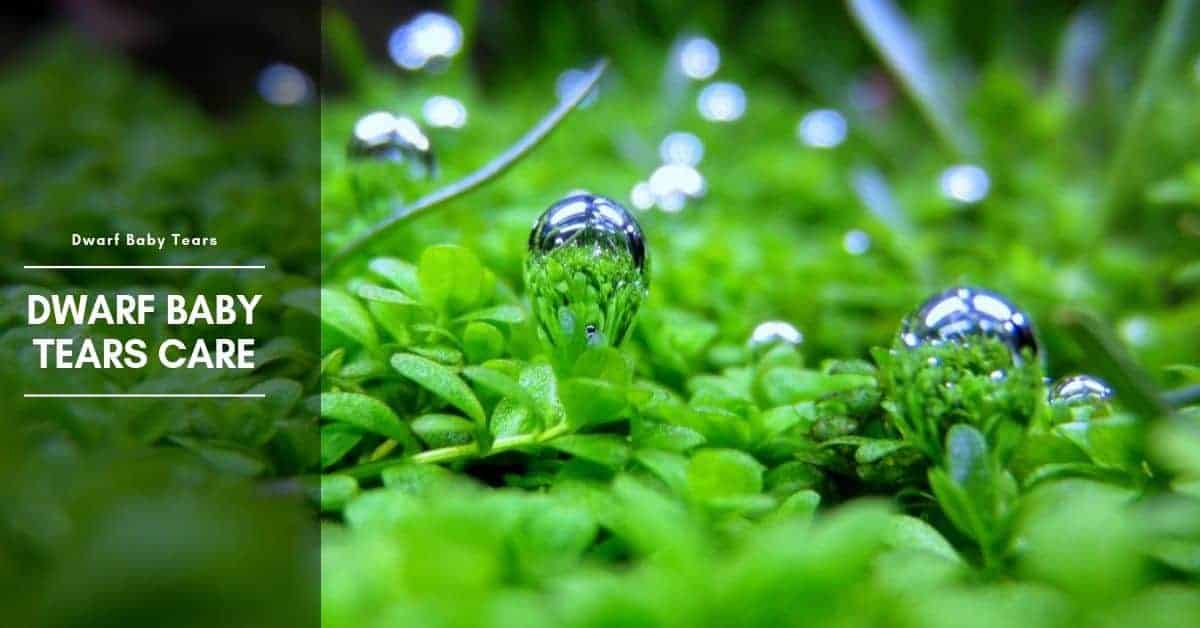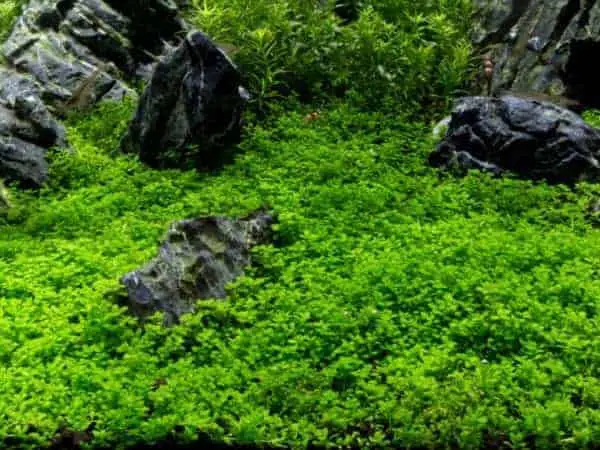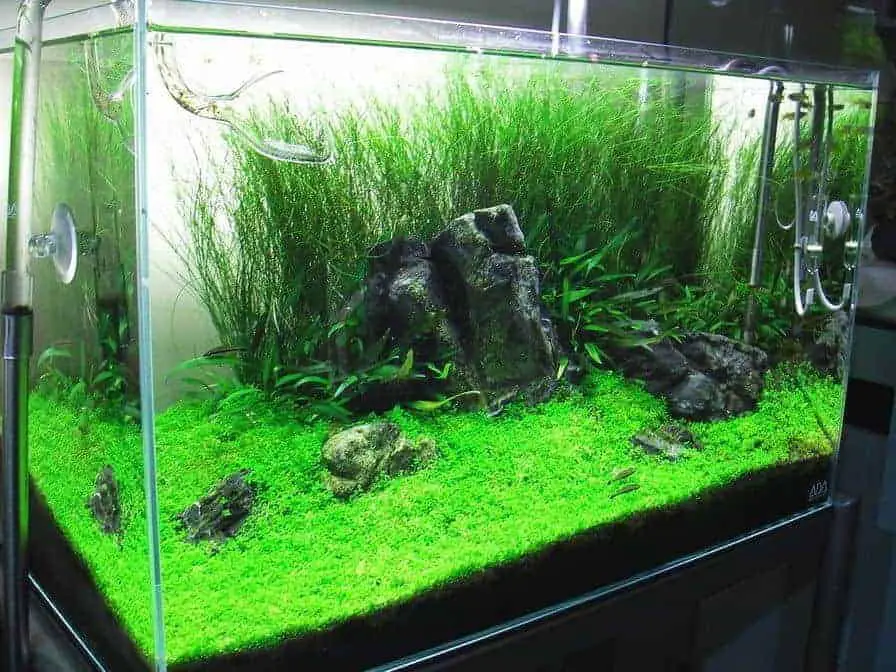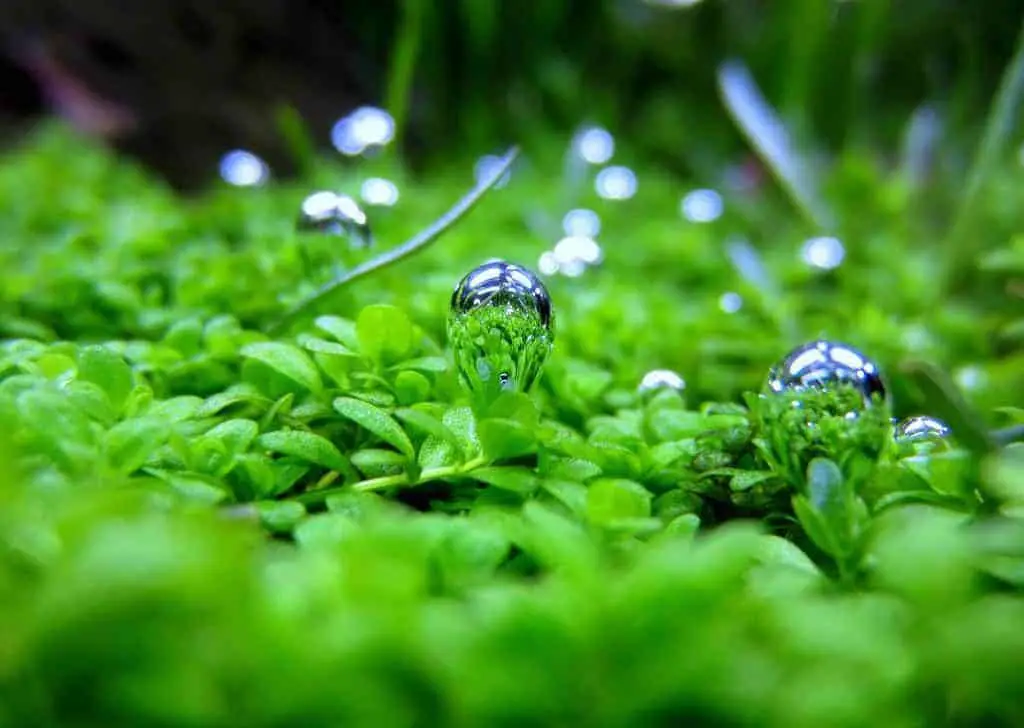Dwarf baby tears (known as Hemianthus Callitrichoides or ‘ HC Cuba’) are by far the most elegant carpeting plant in my opinion. Given the right care and the right conditions, this plant will thrive and slowly cover any exposed substrate in your aquarium.
Tank Requirements
| Temperature | 68-78° Fahrenheit |
| KH | 0-10 |
| pH | 5.0-7.5 |
| Light | High (10 to 14 hours a day) |
| Supplements | Co2 and Fertilizer |
Dwarf baby tears growth rate
Once planted, each portion will produce runners, which are basically individual stems that branch off and grow along the substrate. In order to promote carpeting, high light is very important for this plant.
Dwarf baby tears light requirements is at-least 2 light fixtures on your tank or growing this plant in a short aquarium, where it sits close to the light fixture, is best to provide adequate lighting for this plant.
Co2 is a must as well. I tried growing this plant under high light and nutrients only, and it grew but not very well. it’s already a slow grower, so not providing Co2 to this plant made it grow even slower. So high light and Co2 are a must.
Baby tears plant substrate and nutrient
I would say that dosing nutrients is optional, given I’ve grown this baby tears plant with high light and co2 only for almost two years, and I’ve grown a full carpet of it, but my substrate definitely played a role in this successful growth.
So I’d recommend a nutrient-rich substrate for this plant as well if you decide to not dose any nutrients.
Dwarf baby tears water temperature
Baby dwarf tears are very sensitive to temperature. Grow this plant in a tank that maintains a constant temperature of 78 degrees and below. Anything over that will just make this plant melt.
As far as compatibility, I found dwarf baby tears to be a very hardy plant, compatible with most fish that I would deem not suitable for a planted tank. Once it’s established, not even nippy fish can harm this plant.
However, large fish of course like goldfish and cichlids will just tear this plant apart, so don’t house them with those fish. I learned that the hard way… I’ve grown dwarf baby tears with siamese algae eaters, and no matter how hard they tried, they could not pick out it enough to ruin it or even remove a leaf.
Tetra AquaSafe Plus, 8.45 Ounces, aquarium Water Conditioner And Dechlorinator, Model Number: 46798162681
$8.49 (as of July 13, 2024 11:01 GMT +03:00 - More infoProduct prices and availability are accurate as of the date/time indicated and are subject to change. Any price and availability information displayed on [relevant Amazon Site(s), as applicable] at the time of purchase will apply to the purchase of this product.)API TAP WATER CONDITIONER Aquarium Water Conditioner 16-Ounce Bottle
(as of July 13, 2024 06:40 GMT +03:00 - More infoProduct prices and availability are accurate as of the date/time indicated and are subject to change. Any price and availability information displayed on [relevant Amazon Site(s), as applicable] at the time of purchase will apply to the purchase of this product.)API STRESS COAT Aquarium Water Conditioner 4-Ounce Bottle (85B)
40% OffSo nippy fish will be perfectly fine being housed with this plant, but don’t get crazy with cichlids or goldfish because they’ll just turn it into one expensive salad.
Can I grow dwarf baby tears without co2?
In my experience, Hemianthus callitrichoides need CO2 to thrive. I tried to grow this plant with flourish excel, but the growth rate was very slow.
Fertilizer and plants color
Let’s move on to color, Dwarf baby tears normally appear lighter or dark green in color, but if your tank is lacking vital nutrients like iron and potassium, it may turn a white or yellowish color. And you know, as I said, that’s a sign that your tank is lacking nutrients.
You might want to consider either dosing iron or potassium, or nutrients in general, or growing the plant in a nutrient-rich substrate. If not, you can expect a lot of discoloration, as I said, and sometimes the plant will even just melt away. In order to maintain that nice bright green or dark green color, make sure you give it plenty of nutrients.
Propagation and reproduction
Let’s move on to propagation. Once dwarf baby tears are established in your aquarium, simply cut small sections out of the original portion and replant them. Yes, it’s pretty much that easy. Replanting individual stems, however, isn’t necessary and can be time-consuming.
So removing small portions and replanting them is best. Just make sure each section you replant, has white roots attached to it and plenty of them. If not, that small section on the plant will just melt away.
Carpet plant trimming
Now, when it comes time to trim this plant, it’s not as difficult as it may seem. I would suggest, however, a good sharp pair of scissors to make good even cuts instead of ripping this plant apart with dull scissors.
When you trim this plant, go slowly and only take a tiny bit off the top layer of the carpet. If you start seeing white roots with every cut, you’ve gone too far, this will only make these deep cuts melt away leaving holes in your carpet. So just be careful, go slow, and just snip a small layer off the top.
When it grows back, it will likely appear thicker and fuller as well. But with dwarf baby tears, is already being a compact grower it may be hard to notice nonetheless it’s extremely fun trimming this plan in my opinion.
Dry Start Method
For those of you who don’t know what the dry start method is, it’s where you scape the tank, put in the substrate, put in the hardscape, and then plant the plant without water.
Most people use the DSM (Dry Start Method) with a carpet plant. So you just plant the carpet, spread it very well, and put a clear film on top. You have to keep it like this for a period of 4-6 weeks.
Then you need to give it a daily spray, and you open it so they get some fresh air inside, and what happens it’s like in a nursery. It’s in very high humidity, the plants growing, no water changes, and no algae.
When you have a full dwarf baby tears carpet, you fill the tank with water, and the tank looks good immediately from day one. But then you have to start a cycle again, because the biology is not yet there, and the filter is not running.
Conclusion
So, in conclusion, I think dwarf baby tears are a great carpeting plant, by far the most sought after, the most requested, and I think, just the most beautiful carpeting plant.
They do, however, require co2, nutrients, and high light. This means they are more for advanced supporters or anybody that has a lot of money to invest in a plant tank.
So maybe not the best beginner plant, or even intermediate plant, but more for the advanced aquarist, I think. So I think dwarf baby tears are great for anybody, but you just got to make sure you give them those 3 things, high light, Co2, and nutrients.

Hi, my name is Sean, and I’m the primary writer on the site. I’m blogging mostly about freshwater and saltwater aquariums, fish, invertebrates, and plants. I’m experienced in the fishkeeping hobby for many years. Over the years I have kept many tanks, and have recently begun getting more serious in wanting to become a professional aquarist. All my knowledge comes from experience and reading forums and a lot of informative sites. In pursuit of becoming a professional, I also want to inspire as many people as I can to pick up this hobby and keep the public interest growing.
Read more about Sean.
Please join also my Facebook group.























Hello Sean,
First of all, I would like to mention that your blog rocks!
Is there any way to accelerate the growth rate?
Thank you,
Jack
Hi Jack,
I would consider adding more light to your tank and also try to increase the Co2 level bit more.